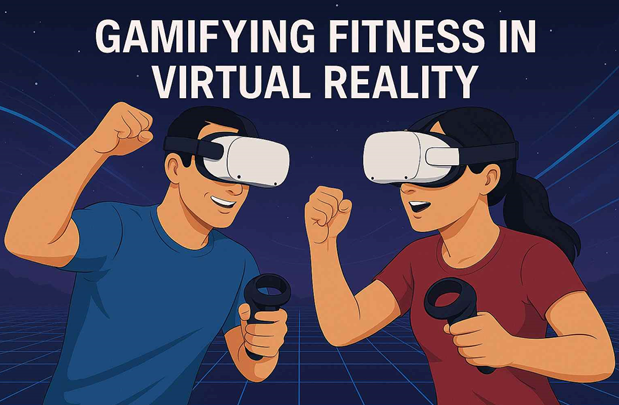In the evolving landscape of fitness and gaming, Virtual Reality (VR) has emerged as a revolutionary tool, creating an intersection where exercise meets interactive entertainment. The gamification of fitness through VR is not just a fleeting trend; it is poised to become a cornerstone of the next billion-dollar industry. With the fusion of immersive gaming environments and physical exercise, VR workouts are transforming how we perceive and engage with fitness.
The Genesis of VR Workouts
The concept of gamifying fitness isn’t entirely new, but the integration of VR technology has propelled it into uncharted territories. Traditional fitness challenges, often repetitive and mundane, are being replaced by dynamic virtual environments where users can engage in a plethora of activities. Whether it’s boxing in a virtual ring, climbing up a majestic mountain, or dancing with holographic partners, VR fitness games offer an unparalleled level of engagement and motivation.
Understanding Gamification in Fitness
Gamification refers to the application of game-design elements and principles in non-game contexts, like fitness. It aims to make exercise more engaging by incorporating points, levels, and rewards, driving users to surpass their fitness goals. In VR, this concept is elevated, providing users with a sense of achievement and progression in a highly immersive setting.
Why VR Workouts Are Gaining Traction
The appeal of virtual reality (VR) workouts stems from their unique capacity to turn otherwise ordinary and repetitive exercises into engaging and exciting adventures that capture the imagination. This transformation is particularly beneficial for those who find traditional workouts to be dull or uninspiring. By taking the strategic step of hiring a skilled virtual reality developer or forming a partnership with a reputable virtual reality game development company, fitness brands have the opportunity to design and implement customized VR experiences. Such tailored experiences can not only enhance the overall workout but also draw in a wide range of individuals who may not typically engage in fitness activities. This inclusive approach can help to broaden the audience for fitness programs and ensure that more people are motivated to participate in physical exercise.
The Role of Interactive Fitness Apps
Interactive fitness apps are pivotal in the gamification of VR workouts. These apps track user progress, offer personalized challenges, and provide real-time feedback, enhancing the overall experience. They also facilitate social connectivity, allowing users to compete with friends or join global leaderboards, adding a competitive edge to their fitness journey.
The Economic Potential of VR Fitness Games
As the demand for innovative fitness solutions grows, so does the economic potential of VR fitness games. The industry is witnessing an influx of investments, with tech giants and startups alike recognizing the lucrative opportunities presented by VR workouts. As more consumers embrace this technology, the market for VR fitness games is expected to soar, reaching unprecedented heights.
Investment in Virtual Reality Game Development
The development of VR fitness games requires a nuanced understanding of both gaming mechanics and exercise science. Companies are increasingly seeking the expertise of virtual reality game development firms to craft experiences that are not only entertaining but also beneficial for physical health. The collaboration between fitness experts and game developers is crucial in creating workouts that effectively target various muscle groups while maintaining user engagement.
Real-World Fitness Games in VR
Immersive Workouts: The Revolution of Traditional Exercises
Virtual reality has the unique ability to transform traditional workouts into engaging, immersive experiences. Fitness games like “Beat Saber” and “Supernatural” are redefining cardio workouts by combining music, movement, and competition. Users can slash through targets or engage in virtual boxing matches, creating an interactive environment that not only enhances physical exertion but also delivers a fun and dynamic workout experience.
Social Connectivity: Competing with Friends in VR Environments
One of the significant benefits of VR fitness games is the social connectivity they provide. Games such as “VRChat” and “Rec Room” allow users to work out alongside friends or compete with others in real-time. This social aspect not only fosters motivation but also encourages a sense of community among users. Through multiplayer challenges, users can encourage one another, which can significantly enhance their commitment to fitness goals.
Tailored Experiences: Customizing Fitness Goals through VR
Many VR fitness games offer personalized experiences that adjust to individual fitness levels and goals. For example, “FitXR” allows users to select workouts tailored to their abilities, ensuring that everyone, from beginners to advanced athletes, can engage effectively. By creating a customizable workout experience, users are more likely to remain motivated and continue their fitness journey in a manner that suits their personal preferences and objectives.
How to Develop a VR Fitness Game: From Concept to Launch
Creating a successful VR fitness game involves a multi-faceted approach that goes beyond just basic game mechanics. Developers must skillfully balance factors such as physical accuracy, gameplay engagement, and hardware optimization to create a product that not only entertains but also promotes fitness. The development process typically includes several key stages:
Market Research: Identifying Target Users
The first step in developing a VR fitness game is conducting thorough market research to identify the target audience. Understanding whether the game is aimed at casual users looking for a fun way to stay active or at serious fitness enthusiasts seeking intense workouts is crucial. This research informs the design choices, ensuring the game meets the preferences and motivations of its intended players. Surveys, focus groups, and competitor analysis can provide valuable insights into user expectations and demands.
Designing Mechanics: Merging Fun and Fitness
Next, developers must design game mechanics that seamlessly blend enjoyment with effective workouts. The goal is to create a gaming experience that motivates players to engage in physical activity while keeping them entertained. This involves crafting gameplay loops that encourage movement, whether through striking, jumping, or dancing, while ensuring the routines genuinely contribute to fitness goals. Incorporating elements like achievements, leaderboard challenges, and rewards can further incentivize regular participation.
Prototyping Movement Mechanics: Safety and Realism
Prototyping is an essential phase where developers test various movement mechanics to ensure they are both safe and reflective of real-world fitness motions. This includes evaluating how users will physically interact with the game—such as determining appropriate ranges of motion and preventing injuries. Developers often leverage motion capture technology and feedback from fitness experts to create accurate representations of exercises that players can perform comfortably and effectively.
Collaborating with Fitness Experts: Validating Workouts
Collaboration with fitness professionals is a pivotal part of the development process. These experts provide insights into exercise science, helping to tailor workout routines that maximize physical benefits while minimizing the risk of injury. This partnership ensures that the game not only entertains but also delivers workouts that are grounded in health and fitness principles. Fitness experts can also assist in creating diverse routines that cater to different fitness levels and preferences, making the game accessible to a wider audience.
User Testing and Iteration: Refining the Experience
User testing plays a critical role in the development of a VR fitness game. Gathering actual player feedback allows developers to identify areas for improvement and make necessary adjustments. This iterative process helps refine gameplay mechanics, user interface, and overall user experience. Participants can offer insights on everything from controls to workout intensity, enabling developers to create a game that resonates with its audience.
The Importance of a VR Game Development Company
Given the technical complexity and unique challenges involved in creating a VR fitness game, hiring a VR game development company becomes essential. These specialized firms possess the expertise and resources to manage all aspects of the project, including game design, programming, and quality assurance. By leveraging their knowledge of VR technology and gaming trends, development companies can help ensure a polished final product that excels in both gameplay and fitness efficacy.
In conclusion, developing a successful VR fitness game is a multifaceted endeavor that requires careful consideration of user needs, effective design, collaboration with experts, and rigorous testing. By following a structured approach, developers can create engaging experiences that captivate users while promoting a healthier lifestyle.
Choosing the Right Game Engine for VR Fitness Development
When it comes to building immersive VR fitness experiences, choosing the right game engine can significantly influence the project’s success. The game engine serves as the backbone of any VR application, dictating how well the experience feels and functions. Among numerous options available, two prominent choices stand out:
Unity: The Versatile Option
Unity is a widely adopted game engine that excels in rapid prototyping and cross-platform VR development. Its user-friendly interface and extensive documentation make it an accessible choice for developers, regardless of their experience level. Key features of Unity include:
- Rapid Prototyping: Unity allows developers to quickly create and test ideas, which is essential in the fast-paced environment of VR fitness, where user feedback plays a critical role in shaping the final product.
- Cross-Platform Compatibility: Unity supports a wide range of VR headsets, including popular devices like Meta Quest and HTC Vive. This cross-platform functionality ensures developers can reach a broader audience.
- Vast Plugin Support: The Unity Asset Store offers a plethora of plugins and assets designed specifically for VR development, including tools for motion tracking, spatial mapping, and animation, which can save considerable development time.
- Animation and Interactivity: Unity is particularly effective for motion-heavy applications that require real-time feedback and user engagement, making it ideal for fitness apps that need to keep users active and entertained.
Many Virtual Reality Developers tend to favor using Unity as their primary development platform. This preference can be attributed to the software’s balanced combination of powerful functionality, user-friendly interface, and cost-effectiveness. These qualities make Unity especially appealing for startups and independent developers who are aiming to establish themselves in the competitive gaming market. By utilizing Unity, these developers can create innovative and immersive VR experiences without the burden of excessive financial investment or steep learning curves often associated with more complex development tools. This accessibility is crucial for those trying to carve out their niche in an ever-evolving industry.
Unreal Engine: The Cinematic Choice
Unreal Engine is another powerful game engine that caters to developers aiming for high-quality visuals and immersive experiences. It excels in scenarios where photorealistic environments and cinematic quality are paramount. Notable aspects include:
- Photorealistic Graphics: Unreal Engine’s rendering capabilities allow for stunning visuals that can make virtual environments feel more lifelike. This is particularly appealing in fitness applications where a visually immersive experience can enhance user motivation and engagement.
- Advanced Physics Simulation: With robust physics tools, Unreal Engine can create realistic workout simulations, adding a layer of authenticity to fitness movements and interactions. This accuracy can be critical in ensuring that users perform exercises correctly and safely.
- Blueprint Scripting: Unreal Engine uses a visual scripting language called Blueprints, which allows developers to create complex interactions without extensive coding knowledge. This can make prototyping and iterating on ideas more efficient.
While Unreal Engine may not be as widely used for VR fitness apps as Unity, it is an excellent choice for developers focused on delivering high-end visual experiences and intricate gameplay mechanics.
Conclusion: Making the Right Choice
Ultimately, the choice between Unity and Unreal Engine will depend on the specific goals and needs of the fitness VR project. For developers prioritizing rapid development, cost efficiency, and broad headset support, Unity is often the preferred engine. In contrast, those aiming for high-end graphics and advanced simulations may find Unreal Engine to be more suited to their vision.
By carefully evaluating the strengths of each game engine, developers can lay a solid foundation for creating engaging and effective VR fitness experiences that meet the evolving demands of users.
Challenges and Opportunities in VR Fitness
While the potential of VR workouts is immense, the industry faces several challenges. High costs of VR equipment, limited accessibility, and the need for continuous content updates are some of the hurdles that developers must navigate. However, these challenges also present opportunities for innovation.
The Future of VR Workouts
The future of VR fitness is promising, with advancements in technology poised to address existing limitations. As VR headsets become more affordable and accessible, a wider audience will be able to experience the benefits of gamified workouts. Moreover, the continuous evolution of VR technology will enable more realistic and varied fitness experiences, keeping users engaged and motivated.
Engaging the Gaming Community
The gaming community plays a vital role in the success of VR fitness. By engaging gamers through interactive forums, discussions, and events, developers can gain insights into user preferences and expectations. This feedback loop is essential for refining VR fitness games and ensuring they meet the demands of an evolving audience.
Sparking Debates and Discussions
Incorporating elements that spark debates within the gaming community can enhance the appeal of VR fitness games. Topics such as the balance between realism and entertainment, the integration of narrative elements, and the ethical considerations of gamified workouts are ripe for discussion. By fostering a sense of community and encouraging dialogue, developers can create a more immersive and inclusive VR fitness experience.
Conclusion
The intersection of fitness and gaming through VR is not just a fleeting innovation; it is a paradigm shift in how we approach exercise. As the industry continues to grow, the potential for VR workouts to become a billion-dollar enterprise is increasingly evident. By harnessing the power of gamification and engaging the gaming community, developers and fitness brands can create transformative experiences that redefine fitness for the digital age.
In this rapidly evolving landscape, the collaboration between game developers, fitness professionals, and technology innovators is key to unlocking the full potential of VR workouts. As we move forward, the gamification of fitness in virtual reality promises not only to reshape the industry but also to inspire a healthier, more active generation.


